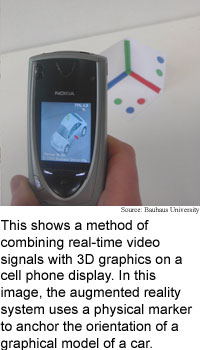
Cell phone melds video and data
By
Eric Smalley,
Technology Research NewsAugmented reality systems combine digital information with real-world objects, often by projecting computer displays onto walls, desk tops or windshields.
A second form of augmented reality melds digital information and real-time video to provide see-through displays that show virtual models or annotations overlaid on real-world scenes. Several teams of researchers have developed such see-through augmented reality systems for laptop computers, head-mounted displays and handheld computers.
Researchers at Bauhaus University in Germany are attempting to bring the technology to the mass market with a video see-through augmented reality system for commercial cell phones. The cell phone system inserts computer-generated three-dimensional models into real-time video shown on the cell phone's display and aligns the models with physical markers in the camera's field of view.
Cell phones are increasingly equipped with cameras and their computational capabilities are improving, said Mathias Moehring, a researcher at Bauhaus University. "Cell phones have the potential to bring augmented reality to a mass market," he said. "This project represents a first evaluation of this potential."
The system could be used to provide, for instance, museum or city guides, said Moehring. "Markers encoding IDs could be captured by the tourist's cell phone," he said. The application would then determine which exhibit the person is looking at and present related information on the cell phone display.
The augmented reality method uses a coordinate system to align three-dimensional graphics within the two-dimensional video display on the cell phone. The researchers used a previously developed algorithm that anchors a three-dimensional model, typically a graphic depicting an object, to a physical three-dimensional marker captured in the video stream. The marker in the researchers' prototype consists of three paper strips of different colors joined at one end to form the corner of a cube.
As the user moves her cell phone, the model rotates in relation to the changing angle between the cell phone and the marker. The system updates the model's position at 4 to 6 frames per second, or about one-sixth the speed of full-motion video, said Moehring.
The marker contains colored dots that form a code that tells the system which computer-generated model to display. The spatial distribution of the dots allows for a large number of codes, according to Moehring.
In order to be simple enough to work on commercial cell phones, the system ignores specific colors and grayscale values and only scans for increases in color intensity, which show up as increases in the video red-green-blue (RGB) channels, according to Moehring. The system also conserves compute power by first scanning for the marker in the same position in the video stream where it was found in the previous frame, under the assumption that the user is not likely to move the camera very quickly, he said.
Cell phones need to improve to make the system practical, Moehring said. "The cameras attached to cell phones have very low resolution and image quality, making optical tracking difficult, [and] cellphones have strict hardware limitations, most notably their speed and memory capabilities."
Other researchers at Bauhaus University are working on allowing the system to track three-dimensional space without markers, said Moehring.
Cell phone augmented reality systems could be practical in the next couple of years, said Moehring.
Moehring's research colleagues were Christian Lessig and Oliver Bimber. They presented the research at the Association of Computing Machinery (ACM) Siggraph 2004 conference in Los Angeles, August 8 to 12. The research was funded by the university.
Timeline: 2 years
Funding: University
TRN Categories: Data Representation and Simulation; Human-Computer Interaction; Computer Vision and Image Processing
Story Type: News
Related Elements: Technical paper, "Video See-Through and Optical Tracking with Consumer Cell Phones," presented at the Association of Computing Machinery (ACM) Special Interest Group Graphics (Siggraph) 2004 conference, Los Angeles, August 8-12.
Advertisements:
August 11/18, 2004
Page One
Projector lights radio tags
Cell phone melds video and data
Sound system lets listeners move
Chips measure electron spin
Briefs:
Twisted fiber filters light
Shifty tiles bring walking to VR
Speck trios make secret codes
Single gold atoms altered
Pen writes micro wires
Design eases nano locomotion

News:
Research News Roundup
Research Watch blog
Features:
View from the High Ground Q&A
How It Works
RSS Feeds:
News
Ad links:
Buy an ad link
| Advertisements:
|
 |
Ad links: Clear History
Buy an ad link
|
TRN
Newswire and Headline Feeds for Web sites
|
© Copyright Technology Research News, LLC 2000-2006. All rights reserved.